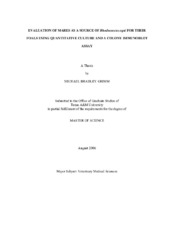| dc.contributor.advisor | Cohen, Noah D. | |
| dc.creator | Grimm, Michael Bradley | |
| dc.date.accessioned | 2010-01-15T00:14:27Z | |
| dc.date.accessioned | 2010-01-16T02:18:02Z | |
| dc.date.available | 2010-01-15T00:14:27Z | |
| dc.date.available | 2010-01-16T02:18:02Z | |
| dc.date.created | 2006-08 | |
| dc.date.issued | 2009-06-02 | |
| dc.identifier.uri | https://hdl.handle.net/1969.1/ETD-TAMU-1873 | |
| dc.description.abstract | Fecal specimens from 130 different mares were collected from an endemic farm for 2 consecutive years at 4 different times pre- and post-foaling (41 mares contributed data in both years). A modified NANAT agar medium was used to quantitatively culture 1-g aliquots of the mare feces without inhibition of growth of Rhodococcus equi. Once the R. equi in the mare feces were quantified and the total concentrations of R. equi determined, a colony immunoblot procedure was performed to detect the presence of the virulence-associated protein antigen on the isolates. This allowed for the proportion and concentration of virulent R. equi to be determined. Foals that were found to have ultrasonographic evidence of peripheral pulmonary abscessation or consolidation underwent aseptic trans-cutaneous tracheobronchial aspiration. Positive results of TBA were used to categorize foals as affected with R. equi pneumonia. R. equi pneumonia developed in 31% of the foals. Shedding of virulent R. equi was observed in at least 1 sampling period for every mare examined, and >33% were culture-positive during all sampling periods. However, significant differences were not observed in either the fecal concentrations of total or virulent R. equi from dams of affected foals compared to dams of unaffected foals. No significant temporal changes in the fecal concentrations of R. equi were observed. It was concluded that dams of affected foals do not shed more R. equi in feces than do dams of unaffected foals, indicating that heavier shedding by particular mares does not explain infection in their foals. However, the finding that virulent R. equi were excreted in the feces of all sampled mares indicates that mares are likely an important source of R. equi for their surrounding environment. | en |
| dc.format.medium | electronic | en |
| dc.format.mimetype | application/pdf | |
| dc.language.iso | en_US | |
| dc.subject | quantitative culture | en |
| dc.subject | colony immunoblot assay | en |
| dc.title | Evaluation of mares as a source of Rhodococcus equi for their foals using quantitative culture and a colony immunoblot assay | en |
| dc.type | Book | en |
| dc.type | Thesis | en |
| thesis.degree.department | Veterinary Large Animal Medicine and Surgery | en |
| thesis.degree.discipline | Veterinary Medical Sciences | en |
| thesis.degree.grantor | Texas A&M University | en |
| thesis.degree.name | Master of Science | en |
| thesis.degree.level | Masters | en |
| dc.contributor.committeeMember | Libal, Melissa C. | |
| dc.contributor.committeeMember | Martens, Ronald J. | |
| dc.type.genre | Electronic Thesis | en |
| dc.type.material | text | en |
| dc.format.digitalOrigin | born digital | en |


